British Aerospace Nimrod AEW3
| Nimrod AEW3 | |
|---|---|
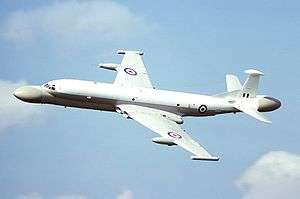 | |
| Nimrod AEW3 | |
| Role | Airborne early warning and control |
| Manufacturer | British Aerospace |
| First flight | 16 July 1980[1] |
| Introduction | 1984 |
| Retired | 1986 |
| Status | Development cancelled |
| Primary user | Royal Air Force |
| Produced | 11 |
| Number built | 3 prototype 8 production (all converted from MR1) |
| Developed from | Hawker Siddeley Nimrod |
The British Aerospace Nimrod AEW3 was a planned airborne early warning (AEW) aircraft intended as to provide airborne radar cover for the air defence of the United Kingdom by the Royal Air Force (RAF). The project was designed to use the existing Nimrod airframe, in use with the RAF as a maritime patrol aircraft, combined with a brand new radar system and avionics package developed by BAE Systems Avionics.
The Nimrod AEW project proved to be hugely complex and expensive for the British government, as a result of the difficulties of producing brand new radar and computer systems and integrating them successfully into the Nimrod airframe. Despite close to a decade's work, the project was eventually cancelled, with the RAF instead purchasing new build Boeing E-3 Sentry aircraft to fulfil the AEW requirement.[2]
Development

Background
In the mid 1960s following the development of the Grumman E-2 Hawkeye carrier-borne AEW aircraft and its associated systems, the British government began looking around for a radar system that could be used to provide airborne early warning for the United Kingdom. At the time, the only recognised AEW aircraft in British service was the Fairey Gannet aircraft used by the Fleet Air Arm on board Royal Navy aircraft carriers. These were fitted with the AN/APS-20 Radar, which had been developed during World War II and was rapidly becoming obsolete.[3] Work had been started in the early 1960s on a brand new AEW platform for the Royal Navy to replace the Gannet that would encompass both a new type of radar system mounted on a new aircraft, the P.139. While the defence cuts of the mid 1960s led to the cancellation of the P.139, work continued on a wholly British designed radar system, while strategic thinking led to a decision being taken that the RAF needed an AEW aircraft to operate as part of the national air defence strategy.[4]
To fulfill the planned requirements for a new land based AEW aircraft, the government had a number of factors to consider:
- The Frequency Modulated Interrupted Continuous Wave (FMICW) radar initially proposed for the P.139 and intended for the RAF's new aircraft would not operate effectively near propellors, meaning a jet aircraft would be needed.
- The size of antennas needed for the required scanning range, together with the fairly large mission crew, meant that a large aircraft was required.
Designers at Hawker Siddeley Aviation came up with a proposal that would see the FMICW radar system installed using a Fore Aft Scanner System in the new Nimrod aircraft. This proposal was rejected as being too expensive, with instead a proposal to convert surplus Andover transport aircraft. This though was also rejected due to the potential cost of development.[4]
In the interim, to provide a land based AEW aircraft, radar systems from withdrawn Royal Navy Gannets were installed in similarly surplus Avro Shackleton maritime patrol aircraft and commissioned into service from 1972.[5] At around the same time, it was decided not to proceed with FMICW technology as the basis of an AEW system, as research from the US Air Force had shown that pulse-Doppler radar was superior and would be used in the brand new aircraft then under development. As a consequence, the idea of a new land-based AEW aircraft for the RAF was re-examined, and again it was decided that the Nimrod met the requirements.[4]

The decision was taken to procure the aircraft fitted with a pulse-Doppler radar system, which then proceeded to a range of options:[1]
- Purchase the AN/APS-125 pulse-Doppler radar system and its associated avionics, as fitted to the E-2 Hawkeye, and fit them into the Nimrod.
- Purchase the AN/APS-125 radar and combine it with a British avionics package.
- Purchase the rotodome and antenna from the E-2 and combine with a British radar transmitter, receiver and avionics package.
- Develop a wholly British radar system and avionics package using a Fore Aft Scanner System (FASS) rather than the E-2 radome.
While the fourth option was the most attractive as far as British industry was concerned, in that it would sustain thousands of British jobs, it was also far riskier than purchasing an "off the shelf" product or spreading the risk across multiple partners. In 1977, the US had made an offer to NATO for purchasing several of the new Boeing E-3 Sentry aircraft, which were being delivered to the US Air Force; this was intended to provide airborne early warning cover for Europe's NATO nations without having to rely on the United States, and eventually came into being as the NATO E-3A Component. However, the complex multi-lateral negotiations eventually led the United Kingdom to pursue the all-British development.[6]
Development issues
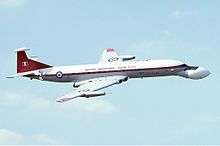
In 1977 an RAF Comet 4 was modified for flight testing with the nose radome and conducted a series of trials, the results of which proved promising enough for an order for three prototype Nimrods to be built using redundant MR1 airframes that became available following the disbanding of 203 Squadron in 1977.[7] The first of these was rolled out in March 1980 and flew for the first time in July, and was intended to test the flight characteristics, with the second airframe planned to carry out trials on the Mission Systems Avionics (MSA) package.[1] The MSA was based around a GEC 4080M computer, which was required to process data from the two radar scanners, the ESM system, IFF and inertial navigation systems. The integration of all of these systems into a single package proved too difficult for the underpowered computer, which had an ultimate data storage capacity of 2.4 MB.[1] Additionally, when operating at full power the radar scanners and on-board electronic systems generated a significant amount of heat. A system was developed to channel this via the fuel system, from where it could then dissipate, but which only worked when the fuel tanks were at least half full.[1]
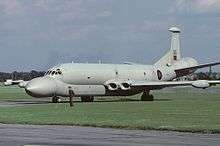
Despite the problems, the Nimrod was persevered with, and 8 production aircraft were ordered (which would also come from spare MR1 airframes), with the first of these flying in March 1982.[7] Even while the technical problems were being worked on, the aircraft was delivered to the RAF, with No 8 Squadron, the RAF's AEW squadron which at that time operated the Shackleton, receiving its first in 1984 to begin crew training.[7] The problem was that, with an anticipated in-service date of mid 1982, No 8 Squadron had been reduced from 12 aircraft and crews to 6 as part of the 1981 Defence Review.[8] By the time of the Falklands War, the Nimrod AEW had been originally scheduled to be in service; however the technical problems proved insurmountable to be deployed in the conflict.[9] To provide some degree of cover, several Nimrod MR.2 were quickly modified to undertake the airborne surveillance role for the task force however.[10]
Cancellation
"...The choice of national procurement rather than the available US alternative, involved not only higher costs for Britain but also the lack of an adequate system in-service when needed... It appears that buying British was given a high priority than having a system available to meet the assessed Soviet threat"
Historians Ron Smith and Jacques Fontanel, discussing the procurement process.[6]
At the time that the first production Nimrods were being delivered to the RAF, the MoD decided to conduct a complete review of the AEW programme. The result of this was the start of a bid process to supply AEW aircraft for the RAF that began in 1986, with a number of different options put forward, including the E-2C Hawkeye, E-3A Sentry, P-3AEW&C Orion, a proposal from Airship Industries, and the Nimrod.[8] Eventually, the Best and Final Offers were sought from GEC Marconi with the Nimrod, and Boeing with its Sentry. In December 1986, the Sentry was finally chosen and the Nimrod AEW programme was cancelled.[7][11] In spite of the project's difficulties however, India expressed interest in procuring the Nimrod AEW3; these investigations continued even after the British government's eventual cancellation of the project.[12]
The Nimrod programme had cost in the region of £1 billion up to its cancellation, contrasting with manufacturer claims in 1977 that the total cost of the project would be between £200–300 million.[6][13] The unused airframes were eventually stored and used as a source of spares for the Nimrod R1 and MR2 fleets, while the elderly Shackleton aircraft that had been commissioned in 1971 as a "stop-gap" measure for AEW cover until the planned entry of the Nimrod were forced to soldier on until 1991 and the entry into RAF service of the Sentry. The scandal over the collapse of the Nimrod AEW project was a major factor in Prime Minister Margaret Thatcher's stance to open up the UK defence market to competition.[14]
Potential future use
Following the cancellation of the Nimrod AEW programme, BAe Woodford began looking at ways that the now redundant airframes could be re-used, and entered into studies looking at the potential use of the Nimrod as a missile carrying strike aircraft. BAe's intention would have seen the AEW modifications, primarily the FASS scanners, and the fuel and cooling systems installed in the weapons bay, removed. The Searchwater radar, at the time fitted to the Nimrod MR.2, would have been installed in a nose installation, and the weapons bay outfitted to accommodate up to six Sea Eagle anti-ship missiles.[15] However, this did not go beyond the study phase, and the airframes were eventually scrapped during the 1990s.[16]
Issues
_117_flies_over_the_California_coast_near_Ventura%2C_Calif._121120-N-HX866-006.jpg)
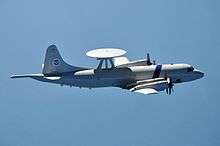

The thinking behind the attempted development of the Nimrod AEW was to maintain Britain's position at the forefront of radar technology and development as part of defence. However, the complexity of the AEW requirement proved too much for British industry to overcome by itself. A major project management issue was the appointment of British Aerospace and GEC Marconi as joint programme leaders. This meant in practice that as development issues arose, the companies had a distressing tendency to blame each other for the problem rather than try to resolve it; while British Aerospace were able to fulfil their half of the contract in delivering the aircraft on time (the first was due to be delivered in 1982, with full delivery by 1984), GEC were unable to solve the difficulties in developing the avionics.[11]
Aircraft
The choice of the Nimrod airframe proved to be the wrong one, as it was too small to accommodate the radar, electronics, power generation and cooling systems needed for a system as complex as the one required[17] – at just over 38.5 m (126 ft), the Nimrod was close to 8 m (26 ft) shorter than the Boeing 707 aircraft that formed the basis of the E-3 Sentry, with the planned all-up weight around half that of the American aircraft, but was expected to accommodate sufficient crew and equipment to perform a similar function.[1] Nimrod was designed to have a total of six operator consoles (4 for the radar, one for ESM and one for communications), which was less than the nine stations fitted aboard the E-3A. The size of the Sentry also meant there was room to increase the number of operators.[1] Having the Sentry's radar in the rotodome above the aircraft allowed for cooling to be undertaken directly by the airflow, with cooling doors mounted in the installation, while the transmitter had a separate liquid cooling system, and the avionics in the main section were sufficiently cooled by a conventional air cycle environmental system.[18] This was in contrast to the Nimrod's "heat sink" design that dispersed the heat through the fuel system, and which needed the fuel tanks to be at least half-full to work efficiently when the aircraft's system operated at full power.[1]
Avionics

The choice of computer to integrate the various sensor systems was wrong, as the GEC 4080M was simply too slow and too underpowered to perform the tasks required of it: by the time of project cancellation, the mission system mean time between failure was around 2 hours, yet it took around 2 and a half hours to load all the mission data via a tape system. What mission performance there was largely due to the Cossor IFF interrogator which complemented the radar system: with the addition of IFF data, the system could successfully track aircraft carrying IFF transponders, but when the IFF was switched off, radar tracks would rapidly be lost. This meant that the system would successfully track civil and 'friendly' military aircraft, but would not reliably detect Warsaw Pact aircraft which did not carry a compatible IFF system – detection of which was the whole point of the project. The mission system electronic racks were earthed to different points on the airframe, which led to differences in earth potential and the introduction of short-lived, random track information which added to the computer overload. Finally, the advanced design of the radar proved difficult – the FASS method to gain full 360° radar coverage was problematic, involving as it did the scanner in the nose making a left to right sweep, with the signal then immediately passed to the scanner in the tail, which would sweep right to left.[19] However, getting the two scanners to synchronise proved difficult, resulting in poor all-round surveillance capability.[1] The system also split incoming raw radar information into upper and lower beams, each of which was then further split into in-phase and quadrature-phase channels. Each of these 4 channels contained identical individual elements (such as a spectrum analyser), which in theory should have been entirely interchangeable between locations. JTU trials showed that in fact the system would only work with a particular device in a particular place in the system: putting the same device in one of the other 3 channels would not give a serviceable system. The consequence of this was that the JTU trials aircraft would fly loaded with spare electronic devices so that when system failure occurred, there was a better chance of finding a particular combination of system elements which would work. This would not have been a sustainable practice had the aircraft entered service. The reason for this issue was never resolved: the JTU suspicion was that tolerances in transmitting information through each channel were too loose, so that as the processed information emerged from each channel to be correlated back into a coherent picture, such correlation was in fact impossible since each channel was offering up a different 'time slot' to the others.
Operators
- Royal Air Force
- Nimrod AEW Joint Trials Unit
Aircraft on display
No complete Nimrod AEW3 survive fully intact, however 3 cockpits/ fuselages are intact
- XV259 - Solway Aviation Museum , Carlisle Airport, Cumbria, England - cockpit only surviving part
- XV263 - Brough , Yorkshire . England - Fuselage used as the fatigue test rig for the Nimrod MRA4 wing.
- XZ287 - Stafford camp, Staffordshire, England - Fuselage only surviving part
Specifications (Nimrod AEW3)
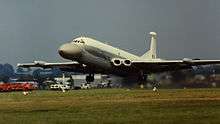
Data from Aeroflight – BAE Systems Nimrod,[7]
General characteristics
- Crew: Up to 12
- Length: 41.97 m (137 ft 8.5 in)
- Wingspan: 35.08 m (115 ft 1 in)
- Height: 10.67 m (35 ft)
- Wing area: 197.05 m2 (2,121 sq ft)
- Empty weight: 39,010 kg (86,000 lb)
- Max. takeoff weight: 85,185 kg (187,800 lb)
- Powerplant: 4 × Rolls-Royce RB 168-20 turbofans, 54.00 kN (12,140 lbf) each
Performance
- Service ceiling: 10,972 m (36,000 ft)
Armament
- Guns: None
- Hardpoints: None
Avionics
- GEC Marconi Argus-2000 Mission Systems Avionics system incorporating:
See also
- Related development
- BAE Systems Nimrod MRA.4
- British Aerospace Nimrod MR.2
- Hawker Siddeley Nimrod MR.1
- Hawker Siddeley Nimrod R.1
- Aircraft of comparable role, configuration and era
- Related lists
References
| Wikimedia Commons has media related to Nimrod AEW3. |
- Notes
- 1 2 3 4 5 6 7 8 9 "BAe Nimrod AEW3". The Spyflight Website. Retrieved 11 May 2011.
- ↑ Aboulafia, Richard (May 2001). "Airborne Early Warning: An affordable necessity?". Aerospace America. Retrieved 12 May 2011.
- ↑ "Airborne Early Warning". globalsecurity.org. 7 July 2011. Retrieved 27 July 2015.
- 1 2 3 Hirst, Mike (1983). "From Skyraider to Nimrod...Thirty Years of British AEW". Air International. 25 (5): 223–230.
- ↑ "The Shackleton Years". no. 8 Squadron RAF. 18 March 2009. Retrieved 25 September 2012.
- 1 2 3 Bellany and Huxley 1987, p. 77.
- 1 2 3 4 5 "BAE Systems Nimrod". Aeroflight. Retrieved 11 May 2011.
- 1 2 "The Nimrod AEW Saga". 8 Squadron History. 8squadron.co.uk. 4 September 2006. Retrieved 11 May 2011.
- ↑ Braybrook 1982, p. 9.
- ↑ Braybrook 1982, p. 40.
- 1 2 George Younger, Secretary of State for Defence (18 December 1986). "Airborne Early Warning Aircraft". Parliamentary Debates (Hansard). United Kingdom: House of Commons. col. 1351–1353.
- ↑ Smith 1994, p. 125.
- ↑ "Could Nimrod Clip AWACS Wings?" New Scientist, 73(1042), 10 March 1977. p. 586.
- ↑ Chin 2004, p. 156.
- ↑ Gibson, Chris (2011). Vulcan's Hammer: V-Force Projects and Weapons Since 1945. Manchester: Hikoki Publications. p. 181. ISBN 978-190210917-6.
- ↑ Hastings, David (4 March 2013). "Nimrod Production". Target Lock. Retrieved 10 June 2013.
- ↑ Kopp, C (March–May 1989). "AEW and AWACS". Australian Aviation. Air Power Australia. Retrieved 12 May 2011.
- ↑ "Boeing E-3A Sentry". Virtual Aircraft Museum. Retrieved 11 December 2013.
- ↑ Hewish, Mark (1981). "Britain's air defences grow new teeth". New Scientist. 89 (1244): 682–684. Retrieved 12 May 2011.
- Bibliography
- Bellany, Ian and Tim Huxley. (Ed.) "New Conventional Weapons and Western Defence". Routledge, 1987. ISBN 0-7146-3310-0.
- Braybrook, Roy. Battle for the Falklands: Air Forces. London, UK: Osprey Publishing, 1982. ISBN 0-85045-493-X.
- Chin, Warren. "British Weapons Acquisition Policy and The Futility of Reform". Ashgate Publishing, 2004. ISBN 0-7546-3121-4.
- Conner, Steve. "Nimrod Reaches to the End of the Runway". New Scientist, 111(1519), 31 July 1986, pp. 33–36.
- Smith, Chris (1994). India's Ad Hoc Arsenal: Direction Or Drift in Defence Policy?. Oxford University Press. ISBN 0-19-829168-X.